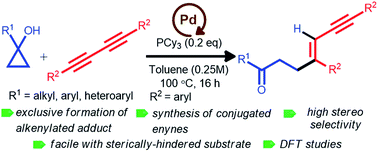Palladium-catalyzed selective C–C bond cleavage and stereoselective alkenylation between cyclopropanol and 1,3-diyne: one-step synthesis of diverse conjugated enynes†
Abstract
The stereoselective synthesis of 1,3-enynes from 1,3-diynes is demonstrated by palladium-catalyzed selective C–C bond cleavage of cyclopropanol. Exclusive formation of mono-alkenylated adducts was achieved by eliminating the possibility of di-functionalization with high stereoselectivity. Indeed, this protocol worked very well with electronically and sterically diverse substrates. Several studies, including deuterium labeling experiments and intermolecular competitive experiments, were carried out to understand the mechanistic details. The atomic-level mechanism followed in the catalytic process was also validated using DFT calculations, and the rate-controlling states in the catalytic cycle were identified. Furthermore, preliminary mechanistic investigations with radical scavengers revealed the non-involvement of the radical pathway in this transformation.



 Please wait while we load your content...
Please wait while we load your content...